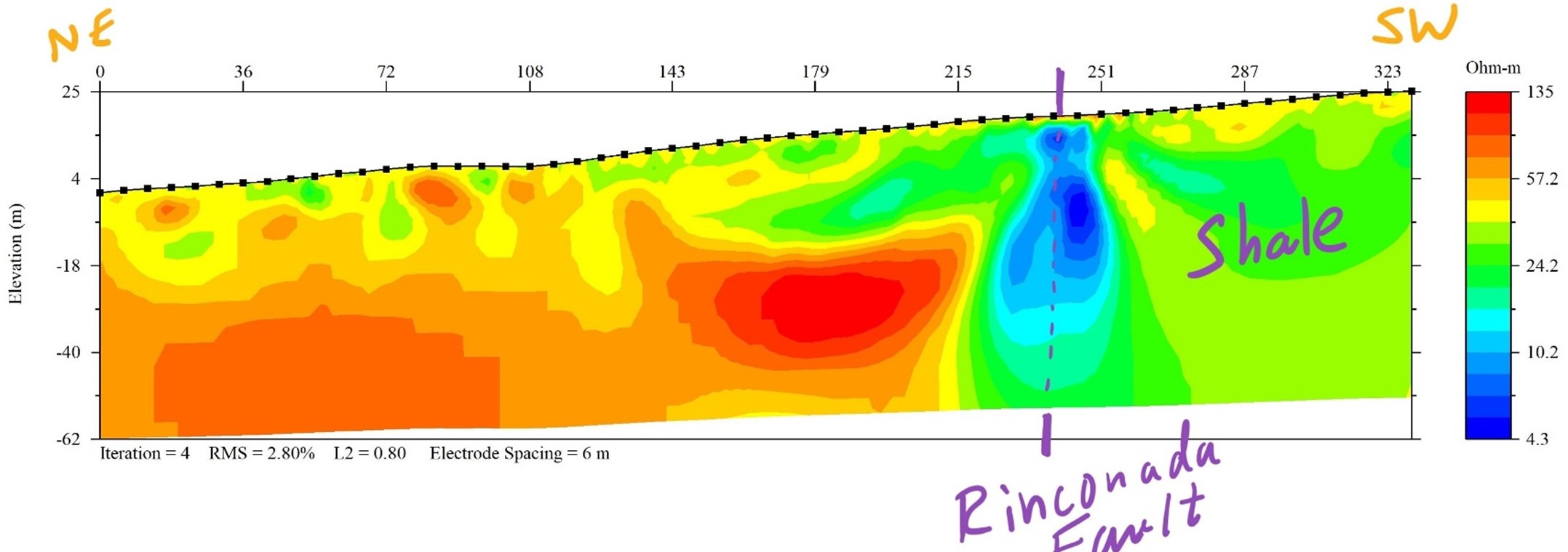

About John Jasbinsek: Geophysicist tucked away for safe keeping in the Department of Physics at California Polytechnic State University, San Luis Obispo.
If you are a student interested in a senior project or other independent study project please use the links above to see an overview of my research interests and/or send me an email.
Courses I teach on a regular basis (Spring Quarter 2024: GEOL 201 and GEOL 305).
One of these days ... I will link up syllabi, websites, etc. to these courses.
I work in and supervise student research and senior projects in the areas of near-surface geophysics (hydrogeology) and global seismology. If you are a student and want to discuss opportunities in these areas feel free to send me an email or stop by my office (Baker Science Room 520) sometime.
I primarily use electrical resistivity tomography to image near-surface geologic structures such as faults, folds, and stratigraphy; the typical application to infer aquifer structure and groundwater resources. In addition, other methods include induced polarization (IP) and self potential (SP), and seismic refraction tomography (SRT).
Below is a two-dimensional electrical resistivity tomography (2D ERT) image collected along the Rinconada Fault in Paso Robles, CA. The southwest side (on right) is shale (exposed at surface) and the northeast side is made up of crushed granite from the Salinian Block (also exposed). Here we are trying to evaluate whether the crushed granites could act as an aquifer for the landowner.
Data was collected by the Fall 2022 Applied Geophysics class using the mighty SuperStingR8 resistivity meter and 56 electrodes at six-meter spacing.

Global seismology analyzes earthquake waves to infer/constrain the earth’s deep interior structure and state.
Currently students have been exploring ultra-low velocity zones (ULVZ) at earth’s core-mantle boundary at 2,900 km depth using PcP and ScP seismic phases.
The image below shows a model fit (red: data, blue: synthetic) of ultra-low velocity zone structure using PcP phase arrivals recorded at a high density array.
The PcP phase arrival shows an ultra-low velocity zone structure at the core-mantle boundary. The best fitting one-dimensional ULVZ model has a thickness of 6.5 km and S-wave velocity decrement of 27.5%.
Interestingly, no density increase or P-wave velocity decrement is needed; in fact, increasing the density and/or decreasing P-wave velocity immediately begins to degrade model fit (with the important caveat that these are only one-dimensional models!).

Students are also modeling ScP waves for anomalous structure at the core-mantle boundary. The image below shows a stack (linear and phase-weighted) of P-waves and ScP-waves. The ScP response is suggestive of a core-rigidity zone (CRZ) structure (Rost and Revenaugh 2001), or → direct link to PDF.

Some observations of a CRZ structure were also detected with ultra-low velocity zone (ULVZ) observations (Rost and Revenaugh 2003) → freely downloadable from Journal of Geophysical Research. The above two references are the only previous CRZ observations in the literature I am aware of.
Class field trips and field research
Studying the potential for deep deep fractured granite in the Salinian Block to be a groundwater resource.
But, nothing else right now ...